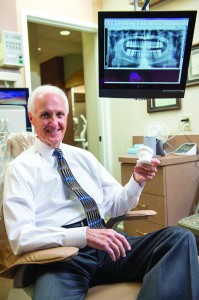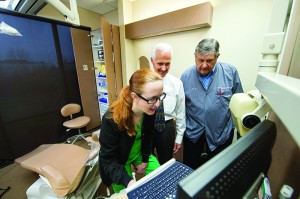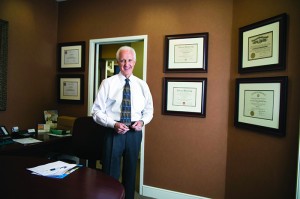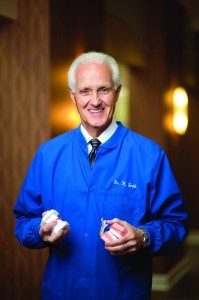AADSM president-elect Harold A. Smith, DDS, promotes dentists working closely with physicians, unbiased dental sleep medicine education, and mentorship among members.

After a chance introduction to dental sleep medicine 22 years ago, Smith immediately saw the value of the niche and how he could translate it into more care for his patients.
Ask healthcare professionals about their first impressions of Harold A. Smith, DDS, and their answers include many similar descriptions: caring, calm, genuine, a man who is fully present in every interaction. In other words, Smith is a relationship builder.
In that way, as well as many others, Smith, president-elect of the American Academy of Dental Sleep Medicine (AADSM), embodies the characteristics of successful dental sleep medicine practitioners. Unlike general dentistry in which a broken tooth is remedied in one or two visits, dental sleep medicine is predicated on long-term relationships with patients, doctors, and at times an entire medical team. Smith’s experiences in 22 years of dental sleep medicine practice make him uniquely suited to being AADSM president in 2016, a position he has held previously.
Professional Practice

Smith’s full-service dental practice has a staff of 12. Smith is shown here consulting with Dr Charles Poland III, a pediatric dental specialist, and staff.
Smith is a diplomate of the American Board of Dental Sleep Medicine and has worked as part of a medical team providing oral appliance therapy to treat obstructive sleep apnea (OSA) since 1993. He is the clinical director of Dental Sleep Medicine of Indiana, which is part of a full-service dental practice that also does family and cosmetic dentistry. Many of his oral appliance therapy patients began as general dentistry patients. “Dental sleep medicine works very well in conjunction with a full practice of dentistry,” Smith says. “Some dentists think if they want to practice dental sleep medicine, they have to do so full time, but they don’t.”
Throughout his professional career, Smith has worked at a full-service dental practice, which became even more comprehensive in 1993 when he added dental sleep medicine services. “In the early days, if you would call a medical insurance company and say you were a dentist using medical codes and treating sleep apnea, they had no idea what you were talking about—and most physicians didn’t either,” he says. “Dental sleep medicine 20 years ago had a trial-and-error feel, with many dentists trying to educate each other. There was no real research and literature about the efficacy of oral appliance therapy then. Physicians had no idea how a dentist would be involved in sleep medicine.”
Dental sleep medicine is not practiced via trial-and-error today. “Now, the entire field is rooted securely in evidence-based practices and research,” Smith says. “And medical insurance companies and Medicare understand the dentists’ role in sleep medicine.”
Amid the changes of the past quarter century, one constant remains: the relationship between dental sleep practitioners and sleep physicians. “Even 22 years ago, we understood that we needed a relationship with our patients’ physicians, which was a very good thing,” Smith says. “As we’ve evolved over the decades, we’ve learned much more about sleep apnea and its comorbidities—such as hypertension, cardiovascular disease, stroke, diabetes, depression, and much more—and we understand the need for our sleep apnea patients to be directly under the care of their physicians. This makes it incumbent upon us as dentists to be in close communication with physicians for our sleep apnea patients.”
Building Relationships

Over the years, Smith has served as president of the American Academy of Dental Sleep Medicine (AADSM), president of the American Board of Dental Sleep Medicine, and received the Distinguished Service Award from the AADSM. He is currently president-elect of the AADSM.
“Back when we first started, dentists assumed that relationships with physicians were important. We didn’t know exactly why until we started to learn more. As the years have gone on, the importance of that dentist-physician relationship has been a guiding light for us,” Smith says. One manifestation of that guiding principle is the AADSM’s relationship with the American Academy of Sleep Medicine (AASM). “The foresight we had in 2002 when the AADSM and the AASM forged our synergistic relationship is amazing. Dental sleep medicine is successful today because of this relationship,” Smith says. “The relationship continues to strengthen and grow, resulting in successful treatment outcomes for thousands every year.”
The AASM and the AADSM’s relationship has resulted in the publication of joint papers that benefit both dentists and physicians, including an updated joint clinical guideline that was posted for public comment in February and soon will be published. “The guideline will provide an updated recommendation for the use of oral appliance therapy and the treatment of OSA and snoring….It will also help identify characteristics of what it means to be well versed in oral appliance therapy, since there is little education for this in dental school,” Smith says. The guideline will also include recommendations for sleep physicians and dentists working together. “The guideline is very powerful in that it supports the relationship and the interaction for both dentists and physicians,” Smith says.
Smith offers this advice to dentists who want to build relationships with physicians: “Physicians want to work with people who are prepared. You do have to get out of your dental office and meet with physicians, whether at their offices or one-on-one at lunchtime, and create relationships with individuals who are serious about sleep medicine themselves and who are happy to have a dentist prepared to help them.” He adds that he does not see oral appliances as competition to CPAP. “CPAP is a wonderful tool to use, and I have never been in competition with CPAP in the 22 years I’ve been doing this. What we find is a significant number of people who are not willing to use CPAP or are not able physically to use CPAP. And then you need another viable option, which can be oral appliance therapy.”
Shalini Manchanda, MD, program director for the sleep medicine fellowship at the Indiana University School of Medicine, is one physician who sees partnering with a dentist who practices dental sleep medicine as an entrée to a wider array of treatment options for patients. “Oral appliances are so portable; patients can stick one in their purse or briefcase,” Manchanda says.
Manchanda lauds Smith for his commitment to two-way communication. “He is tremendous about communicating and always sends a letter back to our office,” Manchanda says. Smith also sometimes visits in person. “Our lab is very knowledgeable about how to do the oral appliance titration, and Dr Smith will come on the nights when he has a patient in the lab and make sure the techs are doing it correctly,” she says. Smith is also a faculty member for the medical school’s fellowship program, which includes the fellows visiting a dental office.
Smith adds that, in addition to creating relationships with sleep medicine physicians, dentists should be prepared to forge relationships with many other medical disciplines, including cardiologists, neurologists, pulmonologists, endocrinologists, bariatric surgeons, and more. “There’s a plethora of physicians out there who are just waiting and are desperate to find someone who can help with another viable technique for treating their sleep apnea patients,” he says.
Smith says the best way for dentists to be welcomed onto medical teams is by explaining their educational course work, including and up to becoming a diplomate of the American Board of Dental Sleep Medicine, a designation that is recognized by the AASM.
Unparalleled Education
Because dental sleep medicine is not regularly taught in dental school, the AADSM wants its education to reach all dentists, no matter what level of dental sleep medicine they ultimately want to practice or what their dental specialty is. “The AADSM is inclusive,” Smith says. “We’d love to have every dentist involved on some level, whatever level they want to be on, and we’re prepared to get them there.” From dentists who want to simply screen for OSA and refer patients elsewhere to those who want to run a practice focusing solely on dental sleep medicine, all are welcome to get education from the AADSM.
Kathleen Bennett, DDS, current AADSM president, says, “The bottom line with the AADSM is the depth of our level of education.” She cites the wide range of offerings from online learning modules, virtual study clubs, and a board review course to in-person practical demonstration courses, advanced courses (which feature new topics and speakers every year), and, of course, the annual meeting.
The AADSM 24th Annual Meeting is June 4 to 6 in Seattle (immediately preceding SLEEP 2015). Bennett says, “The value of the education is phenomenal. We bring in the best researchers, the people who are publishing the papers. And it brings the general dentist, who may be only one of two people in their local community doing dental sleep medicine, into a meeting where everyone is doing dental sleep medicine. It brings them all together and lets them have conversations.” (Dentists do not have to be AADSM members to attend the annual meeting, but members get a discounted rate.)
Nancy Addy, the first dental sleep medicine diplomate in Kansas City and current president of the American Board of Dental Sleep Medicine, says AADSM education is a great first stop on the road to learning about dental sleep medicine because it gives a broad foundation that can then help dentists put into context other course work, such as that offered by manufacturers or through other sources. She says, “I recommend taking your first courses through the AADSM because the AADSM has nonbiased education.” She adds that the intimate, immersive 2-day courses the AADSM offers in cities throughout the country are great for their small group interaction. “You have access to the speakers throughout the 2 days,” she says, adding these events generally give you access to oral appliance manufacturer representatives as well.
Moving into the future, the AADSM educational arm will continue its outreach in hopes of reaching all licensed practicing dentists. Initiatives include lecturing at the American Dental Association’s annual meeting, attending the Greater New York Area Dental Meeting and the Chicago Dental Society’s Midwinter Meeting, and outreach to the Academy of General Dentistry.
Giving Back Via Mentorship

It is Smith’s mission “to educate and bring to treatment the undiagnosed and the unsuccessfully treated people in the state of Indiana with obstructive sleep apnea syndrome.” They need to know there is an oral appliance therapy option, he says.
From its beginnings when peer learning was a necessity through the present day, the AADSM has had a strong mentorship culture. Addy says, “One thing Harold and many other AADSM members say is that once you become a diplomate, you become a mentor to give back. That’s one of the guiding principles of this group of people: You help others.”
Addy herself was mentored by several diplomates, including Smith. “I first met him at an AADSM Annual Meeting and he was just great. I can’t tell you the number of times I called him and asked him what to do,” she says. “He was always a calming force for me, including the time I used the wrong year’s certification guidelines so I didn’t have everything ready to become a diplomate that year. I was in tears, and he calmly told me to continue learning and prepare to take the test the following year. The next time I saw him, I gave him a hug and told him he was right because in that year I learned so much more.”
Addy ensured the mentorship culture passes on by starting a “first time attendee” breakfast at the annual meeting, in which new attendees are seated with other first timers and with leaders on the AADSM board of directors who can share their expertise. “It’s so important for new attendees to make relationships with others who are starting out and also with those who know the ropes. I don’t know of any other organization that bends over backwards to make people feel welcome,” Addy says.
The mentorship culture is also promoted at the AADSM’s highest levels. Earlier this year, the AADSM board appointed a new diplomate to chair the board review course. Bennett says, “Diplomates who just took the exam are the most familiar with the process. We want to draw on their expertise and enthusiasm and share it with the next ‘class’ of professionals.”
Power of Teamwork
Smith is known for saying that dental sleep medicine is not dentistry. Dental sleep medicine practitioners are involved so closely with physician partners that they truly operate as part of a medical team. “We’re dealing in a medical environment. We use medical insurance,” Smith says. “Ultimately, the physician is in charge of the disposition of the patient, and as dentists, we become a very viable, needed, successful part of that medical team. Together, there’s no stopping us.”
Those who want more information on the AADSM are encouraged to visit www.aadsm.org, e-mail [email protected], and call 630-737-9705.
Sree Roy is editor of Sleep Review. CONTACT [email protected]
Dental sleep medicine practitioners can sign up for a free subscription to the print edition of Sleep Review and to our enewsletters: www.sleepreviewmag.com/subscribe



